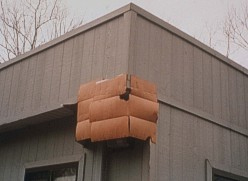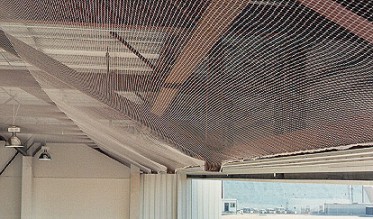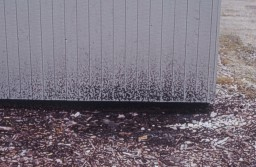|
Handbook Contents | Best Practices Learning Objectives | Assess the Situation | Choose Management Options | Tools and Techniques | Preventing Problems | Evaluating Success | Resources | ICWDM | Wildlife Species Information |
Overall learning objectives for chapter five

- Understand the best practices approach to solving wildlife conflicts.
- Know how to interview people and inspect sites to figure out what caused the problem.
- Describe the different management options available to your customers.
- Be familiar with the techniques used to remove wildlife from buildings and outdoor areas.
- Identify the different euthanasia methods, and know when and why you might use each one.
- Understand how to prevent wildlife damage.
- Know why it’s important to evaluate your practices, and what you can gain from this effort.
Best Practices: Introduction – Learning objectives
- List the five steps involved in the best practices approach to solving wildlife conflicts.
- Give one example of why it’s crucial to properly identify which species is causing the problem.
Step one: Asses the situation – Learning objectives

- Describe two benefits of doing a thorough inspection.
- Give an example of a question you’d ask to figure out whether a problem was caused by a raccoon or a squirrel.
- Describe four kinds of animal sign that you’d look for during an inspection.
- Your knowledge of wildlife habits helps you estimate how many nuisance individuals may be present-before you even get to the site. Describe two biological facts that led you to this conclusion.
- You’ve just noticed something that’s going to change the way you deal with this situation. What was it?
The very first thing you need to do is find the source of the customer’s problem. That means you’ll need to understand the type of damage and how bad it is. You have to identify the culprit. You’ll look for clues that will help you figure out what attracted the nuisance animals to the site. (Remember the two key enticements, food and shelter).
Step two: Choose management options – Learning objectives
- Describe the options for managing a wildlife conflict.
- Explain one way you’d make an area less attractive to nuisance wildlife by actually changing the environment, and one way you’d do this by changing people’s habits.
- List two of the factors that influence the effectiveness of repellents.
- Which management option would almost always be a part of your solution? Why?
At this point in our story, Sherlock would retreat to his apartment, pick up his pipe, and think. So many clues, so many possible solutions: how do you choose?
With a proper species identification, the information you learned during your interview and inspection, and your knowledge of that animal’s life history, you can estimate how many individuals might be present. Again, this will depend on the time of year (is it breeding, rearing young, hibernating, or migrating?), and the animal’s social habits. Woodchucks are generally solitary, while bats are social and are often found in colonies. Is this animal territorial? Will it drive away others at certain times of the year? Does it have a large home range? If so, it might not be able to meet all of its needs just on this site. That could be tricky, because that might mean that the best solution would include addressing a situation on someone else’s property, too, and you might not be able to do that.
All of this detective work is meant to help you decide how many individuals this site would naturally support. Of course, there could be other factors at work here, and you need to take that into account, too. If someone is feeding the wildlife you could encounter unbelievably high population levels, way beyond what the books suggest.
As you consider those questions, you may eliminate some control techniques because they’re not practical, safe, or discreet enough for this situation. Legal restrictions may eliminate some options. The presence of free-roaming pets, children, or protected wildlife might also lead you to favor some approaches and avoid others.
Step three: Do it – Learning objectives
- Name five nonlethal and two lethal techniques for removing animals from an area.
- Once you hit the road, you don’t want to waste time driving back to the office. Describe five pieces of equipment you’d keep in your truck so you could respond to a wide variety of nuisance wildlife calls.
- Which two animal removal techniques require additional training and other licenses or permits?
- List six trapping tips that apply to the use of both live traps and kill traps.
- You need to submit a raccoon for rabies testing. Which killing method can you use?
- Describe how you’d clean an attic that had a family of raccoons living in it. What would you do if they’d been living in the chimney, instead?
With your overall problem-solving strategy in mind, now it’s time to choose the techniques that will help you accomplish your goals. If you decided to do nothing, well then—you’re done. If you’d like to make the environment less attractive to the nuisance animal, you’ll find more information at the Internet Center for Wildlife Damage Managementwebsite. This manual won’t go into any more detail about methods used to reduce local wildlife populations, but you can learn more about that from some of the resources listed in the NWCO Resources section. In this section, we’ll explain some of the best practices for repelling, removing, excluding, and killing animals.
Step four: Prevent future problems – Learning objectives
- List a dozen tips you could share with your customers to help them reduce the amount of food and shelter available to nuisance wildlife.
- Before you exclude an animal from an area, you should think about seven issues. Describe them.
- You’ve been hired to bat-proof a house. Name three products you could use to seal small holes.
- Explain the safety issue you need to consider when modifying vents.
- Raccoons can remove a certain kind of chimney cover. Which one? Describe the type of chimney cover you’d choose to keep a raccoon out of a chimney.
- Name two devices used to keep pigeons off ledges.
Most nuisance wildlife control work is in response to a problem that has already happened. Is there a way to turn that around, to actually prevent problems? Or at least, to prevent them from happening over and over and over again? Absolutely, and this is emerging as a more important part of nuisance wildlife control.
There are two major approaches to preventing wildlife conflicts: habitat modification and exclusion. We’ll also discuss one strategy that’s common in agricultural pest management, which we believe may become an important service offered by some NWCOs: monitoring.
Step five: Evaluate success – Learning objectives

- Describe two benefits you might gain from evaluating your work.
- List three different evaluation methods.
Higher, deeper, further…optional activities to explore other perspectives about this topic
Step one: Asses the situation – Optional activities
- Ask a friend to pretend to be one of your customers. Interview your friend about the problem, then inspect the premises and share your advice.
- Jot down a few questions you might ask customers that would help you identify which animal is causing the damage.
- Go to a bookstore or library to browse through the latest field guides to animal signs.
- Visit a zoo or nature center that exhibits some of the animals you might encounter in your job. Spend some time watching them. Close your eyes, and pay attention to the odor. Talk to staff about the species’ habits. How would they know if that critter was present?
- Start your own wildlife sample charts, to help you identify species by their fur, feathers, or shed skins. You can collect samples from the animals you trap.
Step two: Choose management options – Optional activities
- Survey your NWCO friends to find out which management strategies they use most often. Are they happy, or do they wish they could change things?
- Find out if any nearby communities are actively trying to control white-tailed deer or Canada geese. What’s happened so far? How is it working?
- Search the web for fact sheets that explain why some temporary wildlife conflicts happen (such as robins pecking at windowpanes, or woodpeckers drumming on gutters). Create a file to help you respond to customer questions.
Step three: Do it – Optional activities
- Check catalogs or websites to compare different commercial models of carbon dioxide chambers. Consider buying one, or make your own.
- Attend the DEC fur trapping course to learn more about trapping techniques.
- If you’re unfamiliar with certain humane killing techniques but would like the option of using them in your NWCO work, find an experienced wildlife professional who can teach you. Some techniques should be practiced on dead animals (cervical dislocation, decapitation, stunning).
- Attend the DEC hunter education course or an NRA-sponsored firearms safety course, or the pesticide applicator course, if you’d like to use firearms or pesticides (including repellents) in your NWCO work.
- Create the kind of stinky situations you might encounter on the job, then experiment with ways to control the odors. Try out various odor control products. Which work well?
- Read the 2000 Report of the American Veterinarian Medical Association Panel on Euthanasia. In addition to the added information in this report, it has an extensive bibliography that would lead you to other credible sources of information.
- Collect animal skulls. Use them to help employees understand the proper location of a head shot for each of the species you handle (if shooting is a preferred killing method for that species).
Step five: Evaluate success – Optional activities

- Design a postcard you could use to ask your customers to evaluate your work.
- Write a few questions you might ask customers when calling to discuss their satisfaction.
- Start keeping track of the costs of each job. Figure out your profit margin.
- Find a small group of trusted NWCOs who all want to improve their skills. Get together once a month to share tips and discuss any problems you encountered on the job.
- Join a professional organization. It’s a great way to learn from your peers, and to find out about new developments in the industry.
- Learn more about housing construction. How does the unseen, internal structure of walls, roofs, and foundations affect your NWCO work? Talk to some contractors. Ask them where buildings are most vulnerable, and therefore, more likely to be invaded by wildlife.
Review Questions
Step one: Asses the situation
1. You’re called to a home to deal with a rodent problem. Your customer has three dogs and a toddler. That makes you think:
- a. No wonder the place smells
- b. I should attach the mouse traps to beams, where the dogs and the child can’t reach them
- c. Why aren’t these lazy dogs taking care of the mice?
- d. I could set out live traps, which would be safer for the kid
- e. Answers “b” and “d” correct
- f. Answers “b,” “c” and “d” correct
2. When you first talk to your customer to gain information about the nature of the wildlife conflict, you might ask:
- a. “What can you tell me about this problem?” and “Why didn’t you call earlier?”
- b. “What’s going on?” and “Can you pay for this?”
- c. “What have you seen and heard?” and “When do you notice the problem?”
- d. Very little, because they always lie
3. There’s a noise in the dropped ceiling. Your customer’s not sure what it is, but you know it could be a rodent or a bird. Your truck is packed tight, so you want to make sure you bring the right equipment for the job. What question do you ask her?
- a. When do you hear the noises, during the day or at night?
- b. How loud is it?
- c. Where are the noises coming from?
- d. You mind if I leave this skunk in your driveway while I finish up my route? That would make it easier for me to fit everything into my truck without going back to the office.
4. Your customer just bought an old house. They’ve been told there’s a bat or two in the attic, but they were too scared to check. They want to know how many are up there, and have them removed before they move into the house, which they’re planning to do the first week in July. Because you’re the wildlife Sherlock Holmes, you tell your customer you’d be glad to help, but:

- a. This time of year, there’s a good chance there’s more than one or two bats in the attic. There could be a whole colony of females raising their young.
- b. You can start now, and make sure that the bats can’t get from the attic into the living spaces. But you’d like to let this batch of young leave on their own, which they’ll do by mid-August. Once they’re gone, you can finish bat-proofing the house.
- c. The bat’s probably long gone. Don’t worry about it. You’ll never go into the attic, anyway.
- d. Answers “a” and “b” are correct.
5. You think there’s a mammal in the office. While inspecting the kitchen, you’d look for these signs (check all that apply):
- ___ gnaw marks on the cabinets
- ___ droppings in drawers and by the kickboards
- ___ smudge marks on the baseboards
- ___ urine stains on walls and woodwork
- ___ holes chewed in cereal boxes and other stored foods
- ___ burrows
- ___ piles of nuts and seeds in a cabinet that’s not used often
- ___ odors
- ___ fur
- ___ tracks
- ___ noise
- ___ the creature
- ___ pets scratching at a wall
- ___ livestock remains
- ___ broken egg shells
- ___ nest
- ___ crop damage

Answers:
- e
- c (these questions will help you identify which species is present. Some of the questions address reasonable concerns, but in a tactless manner.)
- a (rodents and birds might be active in some of the same places. Most birds are diurnal. All of the ones most likely to cause problems in homes are. Rodents may be active at night, too).
- d
- Most of these signs are made by rodents, except for livestock remains, broken egg shells, and crop damage, which you wouldn’t expect to see in a kitchen. Rats do burrow, but usually outside.
Step two: Choose management options

1. To make an area less attractive to nuisance wildlife, you might persuade your customers to:
- a. keep the area around the bird feeder clean
- b. remove dog feces from the yard every day
- c. store the trash cans in the garage, then put them out right before the trash pick-up
- d. all of the above
2. To make a park less enticing to Canada geese, you advise the city officials to:
- a. pave over the grass
- b. hold firework displays every night at 8 p.m.
- c. let the grass around the pond grow taller
- d. release wolves
3. In nearly every job, you’d expect to do this, or might advise your customers to take care of it. What is it?
- a. clean up the area with antibacterial soap
- b. tell the neighbors they’ll be next. But if they hire you now, there’s a 10% discount
- c. nothing
- d. exclusion, to prevent problems
4. Your customer tried a bird scare device, but it didn’t work. He wants to know why. You explain (choose all possible reasons):
- ___ birds can’t hear ultrasonic sounds
- ___ the birds get used to seeing it there, so it’s not scary anymore
- ___ you played the alarm call of a crow, but those are starlings roosting in your tree.
- ___ your border collie is a wuss. When I drove up, the Canada geese were chasing your dog!
- ___ scare devices never work
5. Your customer wants to consider every option for solving his wildlife problem. You say:
- a. Well, there are several approaches. I could trap it, or try to scare it off, or put down some pesticides. That’s about it. Trust me, let me trap the animal and take care of it for you. If we use pesticides, the squirrels could die in the walls, and that would stink so bad you’d be sorry you did it. You don’t have to see a thing. But I don’t have the time to talk all day.
- b. That’s a trade secret. Don’t you have to go to work, or something?
- c. It mostly comes down to capturing the animal. We can live trap the animal, or use a lethal trap. If I see the animal, I might be able to catch it using my catchpole. I’d probably set this cage trap. Do you want to release the squirrels alive, or do you want me to take care of them? Because if you let them out, they might just get back in, so then it’s important to fix all the holes to prevent that.
- d. Some wildlife problems stop after a short time, so you don’t have to do anything. That’s not true here. I suggest we use a combination of approaches. We make the place less cozy for the squirrels, while I work on removing them. You can try to scare them away. When we’re done, we fix all the holes so they can’t get back inside.
Answers
- d
- c
- d (remember, most wildlife diseases that are common in the Northeast are not caused by bacteria, so an antibacterial soap isn’t going to help that much. Choose a disinfectant, such as dilute bleach, instead.)
- The only answer that’s flat-out wrong is the one that suggests that scare devices and repellent techniques never work. It’s unlikely that a border collie would be afraid of geese. This is one of the best breeds of dog to choose for hazing geese.
- d
Step three: Do it
1. To use certain techniques, you need additional training and other licenses. This is true for (Check all that apply):
- ___ trapping
- ___ use of pesticides
- ___ installing one-way doors
- ___ use of barbiturates
- ___ hazing with dogs
- ___ use of chemical repellents
2. If you must submit a specimen for a rabies test, certain techniques should not be used to kill the animal. Which ones could interfere with the test? (Check all that apply)
- ___ shooting (in the head)
- ___ cervical dislocation
- ___ carbon dioxide chamber
- ___ decapitation
- ___ lethal trap
- ___ stunning and exsanguination
3. Which of the remaining techniques would you avoid using in this case, because they might put you at risk? (Check all that apply)
- ___ shooting (in the head)
- ___ cervical dislocation
- ___ carbon dioxide chamber
- ___ decapitation
- ___ lethal trap
- ___ stunning and exsanguination
4. Select the nonlethal techniques a NWCO can use to remove an animal from an area. (Check all that apply).
- ___ one-way door
- ___ direct capture
- ___ snare
- ___ foothold trap
- ___ hazing with radio-controlled car or boat
- ___ chemical repellents
- ___ cage trap
- ___ hazing with dogs
- ___ homemade repellents
- ___ visual scare devices (scarecrows, mylar tape)
- ___ noisemakers (propane cannons, bangers)
5. Select the lethal techniques for removing an animal from an area that are available to NWCOs without additional licenses:
- a. lethal trap and shooting
- b. shooting and chemical repellents
- c. rodenticides or other pesticides
- d. barbiturates and CO2 chamber
6. If you could only pack 5 things to respond to a variety of wildlife problems, which items would you pick?
- a. catchpole; a few cage traps in different sizes; flashlight; a few body-gripping traps in different sizes; and a few kinds of gloves.
- b. A selection of firearms; bleach solution; rodent baits; a few foothold traps in different sizes; catchpole
- c. One-way door; nets; pyrotechnic devices; catchpole; a few cage traps in different sizes
- d. Snake tongs; buckets; respirators; glue boards; a shovel.
7. Which of the following techniques is recommended for cleaning up an area that’s been contaminated by raccoons?
- a. Your only option is to burn everything
- b. Burn what you can, then clean the rest with boiling water and bleach, or bury materials deeply
- c. Wet contaminated materials with a disinfectant, then double-bag for disposal
- d. Vacuum the area
Answers
- Pesticides, chemical repellents, barbiturates
- Stunning and shooting in the head would damage the brain. This makes it more difficult to work with the sample—but if you’ve used this technique and need to submit a sample, do it. They may still be able to get valid test results. With a small animal, you might also want to avoid using lethal traps, because it might misfire and hit the head. This isn’t much of a problem with animals as big as raccoons or skunks, so for them, this could be acceptable.
- We’ve already ruled out shooting and stunning, and in some cases, lethal traps. To protect yourself from catching rabies, you need to avoid bites, scratches, and contact with saliva or brain tissue. It’s best to minimize handling of the animal, and to avoid contact with the head. For those reasons, you might avoid the techniques of decapitation and cervical dislocation (which isn’t used on the three rabies vector species—raccoon, skunk, and bat). Both involve handling the animal, and close contact with the head. A CO2 chamber is a much safer option for the operator.
- The only things in that list that NWCOs can’t use are: snares (illegal in NY, with one exception); chemical repellents; homemade repellents (illegal even if you have a pesticide applicator license). Pyrotechnic devices may be prohibited in certain areas.
- a (barbiturates are injected, so you need a permit to use a hypodermic—in addition to the supervision by a DEA-registered vet. Chemical repellents and rodenticides are pesticides and require a pesticide applicator license.)
- a (all of the items are useful to solve certain wildlife problems, but some are more versatile than others. For example, answer “d” includes items that would be very useful if you specialized in snake removal, but not so good for skunks. Some of the items can only be used in certain situations, such as firearms, body-gripping traps, and pyrotechnic devices. Firearms and pesticides (rodent baits) also require additional licenses. Flashlights, respirators, and bleach solution would be good to have along, too).
- b (Raccoon roundworm eggs are resistant to disinfectants. Vacuuming may remove some eggs, but it’s not practical outdoors).
Step four: Prevent future problems

1. Which type of chimney cover is best to use if you’re trying to exclude a raccoon?
- a. one that slips inside the tile liner
- b. one that bolts to the outside of the chimney
2. Before you modify a vent to make it animal-proof, you should:
- a. clean it
- b. check the ventilation requirements of the equipment to make sure your modification meets fire safety standards
- c. paint it
- d. spray it with a repellent
3. Just as there are issues to consider before you choose a removal method, there are 7 things to think about before you exclude an animal from an area. They are:
- a. practicality; legality; effectiveness of technique; safety; does the customer like the product; could there be young trapped inside; do I have to use a ladder; and is it weather-proof?
- b. Local laws; effectiveness of technique; safety; speed; cost; do I have time to do this now; how good does it look?
- c. Could animals be hibernating inside; is the technique effective; what are the chances of trapping young inside; is this legal; am I sure I removed all of the animals? Is this safe; and how will it look when I’m done?
4. To keep pigeons off a ledge, you could use:
- a. plastic strips and ultrasonic devices
- b. porcupine wire and electric shock devices
- c. netting or parallel cables stretched tightly across the ledge
- d. metal coils or bubblegum
- e. answers “b” and “c” are correct
5. To keep bats from crawling through small holes, seal the holes with:
- a. caulk, 1/2″ hardware cloth, expanding foam
- b. 1/4″ hardware cloth, copper gauze, caulk
- c. aluminum flashing, expanding foam, sealant
- d. answers “b” and “c” are correct
6. Select all of the tips you’d suggest to a customer to help them reduce the amount of food and shelter available to mice:
- ___ keep area under the bird feeder clean
- ___ maintain a foot-wide gravel border around the foundation
- ___ enclose the compost pile
- ___ rake up fruits and nuts that have fallen off trees
- ___ clean up spills of food, grain, garbage
- ___ mow the grass, and keep shrubs well-trimmed
- ___ remove brush piles, junk piles, clutter
- ___ store food in strong containers
- ___ remove pet food once they’re done eating
- ___ wrap trees with tree guard
- ___ don’t stack things against the foundation
- ___ store goods, especially grains, pet food, and bird seed, off the floor and away from the walls
- ___ switch to landscape plants that mice don’t find as tasty
- ___ bring chickens into their coop at night
- ___ keep livestock feeding areas and grain storage areas as clean as possible
- ___ animal-proof the trash
- ___ don’t leave the trash out at night
- ___ keep livestock in protected areas
Answers
- b
- b
- c (answer “a” missed concerns about trapping animals inside, either because they’re hibernating, young and immobile, or because you missed some while trapping. It also forgot to mention your safety. Answer “b” missed concerns about hibernating animals and some that might have been missed during your capture).
- e (answer “a” is wrong because birds can’t hear ultrasonic devices, so they don’t respond to them. Answer “d” is wrong because bubblegum won’t deter pigeons).
- d (the mesh size of the hardware cloth in answer “a” is too big for bats).
- Almost all of these ideas apply to mice, except: mice don’t attack livestock. They’re also not as likely to damage trees or landscape plants, although they might do so. It’s true that mice are not strictly nocturnal, but they are more active at night, so there may be some benefit to removing trash at night.
Step five: Evaluate success
1. To evaluate your work, you might:
- a. call you customer
- b. send a postcard or email questionnaire
- c. visit the site again
- d. all of the above
2. What benefits might you gain from evaluating your work?
- a. you can compare the long-term effectiveness of different products and techniques
- b. you further impress your customers, which is good advertising for your business
- c. you can determine your profit margin, which may guide your business planning
- d. all of the above
Answers
- d
- d

Handbook Contents
Introduction
- Understanding Nuisance Wildlife
- The Business Side
Needs of People and wildlife
- Six Questions NWCOs must ask
- New York State Wildlife Control Laws
- Local Regulations for Wildlife Control
Safety Risks for Customers
- Job Risks
- Safety Gear
- Carcass Disposal
- Wildlife Diseases
Best Practices for Wildlife Control
- Assess the Situation
- Choose Management Options
- Tools and Techniques
- Preventing Problems
- Evaluating Success
Professionalism
Resources for NWCOs
Disclaimer
This manual was written as a guide to train nuisance wildlife control operators in New York State. Laws and regulations may differ in your state. Always consult local and state laws before implementing wildlife damage management activities.
Contact Information
Contact your local Extension Office
Resources
Internet Center for Wildlife Damage Management
National Wildlife Control Operator’s Association
Wildlife Control
Acknowledgments
We thank the New York State Department of Environmental Conservation for contributing this information.
Produced by the NYS Department of Environmental Conservation, Cornell Cooperative Extension, and the NYS Integrated Pest Management Program.
